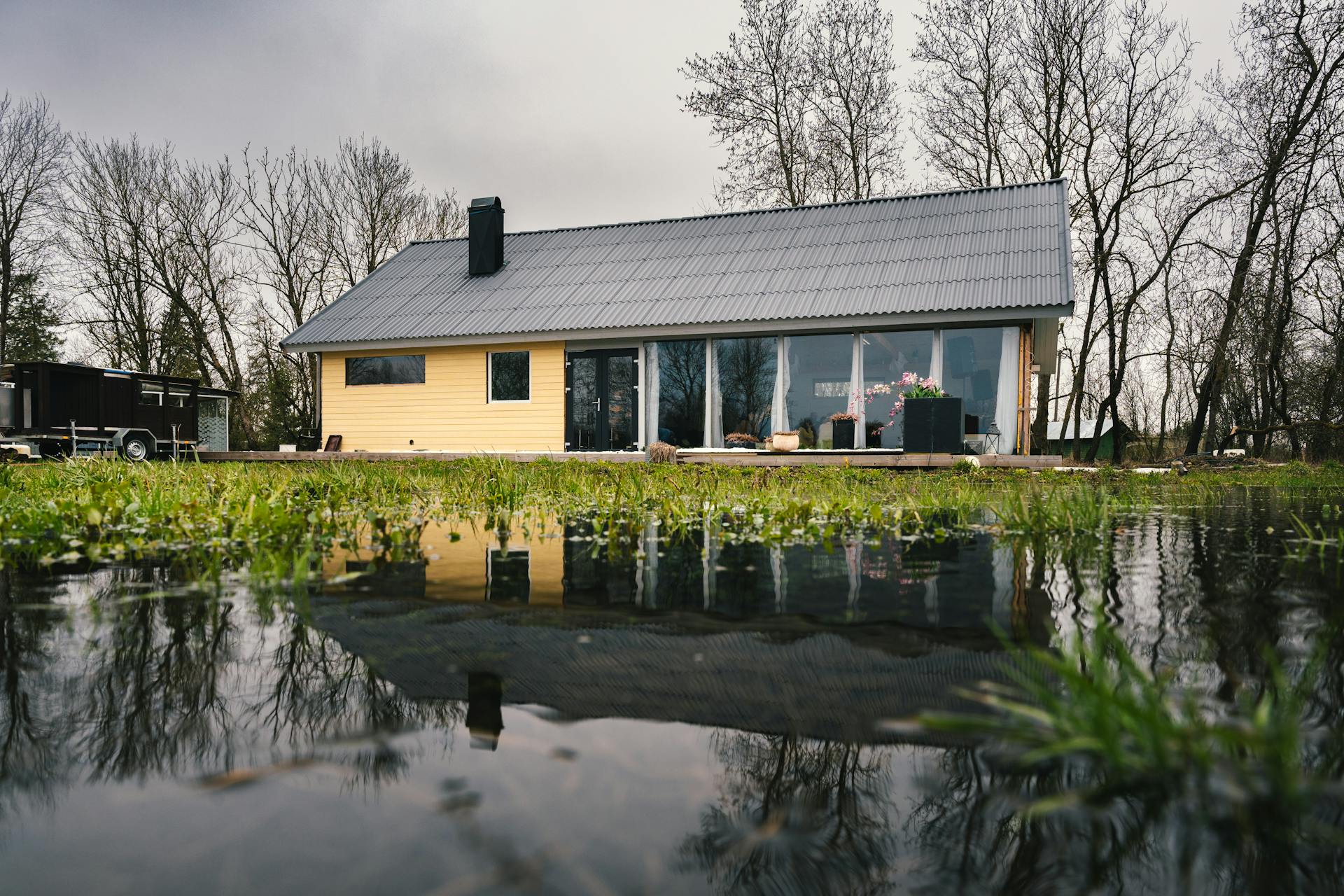PROPERTYSPARK ARTICLE
How Eco-Friendly Waterfront Houses Make Your Home Beautiful and Sustainable
In recent years, the shift towards eco-friendly living has gained momentum, with homeowners and builders increasingly recognizing the importance of sustainability. Building an eco-friendly waterfront house not only enhances the natural beauty of the surroundings but also contributes significantly to environmental conservation. In this article, we’ll explore why eco-friendly houses are important, the best places to build them, how they inspire others, their environmental benefits, and how they add to the aesthetic appeal of waterfront living.

Why Eco-Friendly Houses Are Important
The significance of eco-friendly houses extends beyond individual benefits, impacting broader ecological and societal contexts. Here are a few reasons why building an eco-friendly home is crucial:
- Environmental Conservation:
- Energy Efficiency:
- Health Benefits:
- Long-Term Savings:
Traditional construction methods and materials often deplete natural resources and produce significant waste. Eco-friendly homes utilize sustainable materials and construction practices, reducing the carbon footprint and conserving resources.
Eco-friendly houses are designed to minimize energy consumption through efficient insulation, renewable energy sources like solar panels, and energy-efficient appliances. This not only lowers utility bills but also reduces reliance on fossil fuels.
Conventional building materials can emit harmful chemicals and pollutants. Eco-friendly homes use non-toxic materials, ensuring better indoor air quality and promoting the health and well-being of the occupants.
While the initial investment in eco-friendly construction might be higher, the long-term savings on energy bills, maintenance, and healthcare costs make it a financially sound choice.
Choosing the Appropriate Place to Build
Location is a critical factor in the success of an eco-friendly waterfront house. Here are some key considerations when selecting a site:
- Proximity to Water: Ensure the house is built safely from the waterline to prevent flooding and erosion. Elevated areas protect while offering stunning views.
- Solar Exposure: A site with ample sunlight is ideal for maximizing the efficiency of solar panels. South-facing slopes typically receive more sunlight, making them perfect for harnessing solar energy.
- Wind Patterns: Understanding local wind patterns can help design natural ventilation systems, reducing the need for artificial cooling.
- Access to Resources: Choose a location that provides easy access to sustainable materials and services. Proximity to recycling centers, green building suppliers, and local produce markets can enhance the sustainability of your home.
- Biodiversity Preservation: Opt for a location that allows you to preserve and protect local flora and fauna. Incorporating native plants in landscaping supports local ecosystems and reduces water consumption.
Encouraging Others to Build Eco-Friendly Homes
Building an eco-friendly waterfront house can serve as an inspiration for others. Here’s how:
- Demonstrating Feasibility: By successfully constructing and maintaining an eco-friendly home, you can show that sustainable living is not only possible but also practical and beneficial.
- Community Engagement: Share your experiences and knowledge with the community. Hosting open houses, workshops, or seminars can educate others about the benefits and methods of sustainable building.
- Social Media Influence: Use social media platforms to document your journey. Sharing tips, progress, and benefits can reach a wider audience and encourage others to consider eco-friendly practices.
- Collaborative Projects: Partner with local schools, environmental groups, and government bodies to promote green building initiatives. This collective effort can amplify the impact and foster a culture of sustainability.
Environmental Benefits of Eco-Friendly Waterfront Houses
Eco-friendly waterfront houses offer numerous environmental benefits, making them a cornerstone of sustainable living. Let’s delve deeper into each of these benefits:
- Reduced Carbon Footprint:
- Renewable Energy Sources: Solar panels, wind turbines, and geothermal systems are common features in eco-friendly homes. These renewable energy sources replace the need for fossil fuels, which are major contributors to carbon emissions. By harnessing natural energy, these homes produce clean, sustainable power.
- Energy-Efficient Systems: Advanced insulation, energy-efficient windows, and doors, and high-efficiency HVAC systems reduce the amount of energy needed to heat, cool, and power the home. LED lighting and energy-efficient appliances further lower energy consumption.
- Passive Solar Design: The design of eco-friendly homes often incorporates passive solar principles. This means the house is oriented and constructed to maximize natural light and heat during the winter while minimizing heat gain during the summer. This reduces the need for artificial heating and cooling.
- Conservation of Natural Resources:
- Reclaimed Wood: Using reclaimed wood from old buildings or furniture reduces the demand for new timber, preserving forests and promoting biodiversity.
- Bamboo: As one of the fastest-growing plants, bamboo is a sustainable alternative to traditional hardwood. It’s durable, versatile, and can be used in flooring, cabinetry, and furniture.
- Recycled Metal: Utilizing recycled metals like steel and aluminum for structural components and finishes minimizes the need for new mining activities, which can be environmentally destructive.
- Innovative Materials: Eco-friendly homes often incorporate innovative materials like hempcrete, a concrete-like material made from the hemp plant, which is both sustainable and effective for insulation.
- Waste Reduction:
- Recycling and Reusing Materials: Construction projects often generate a significant amount of waste. Eco-friendly practices include recycling construction debris and reusing materials whenever possible. For example, scrap metal can be melted down and repurposed, and excess wood can be used for other building projects.
- Design Efficiency: Thoughtful design can reduce material waste. Modular construction and prefabricated components are cut to precise measurements in a factory setting, reducing the amount of waste produced on-site.
- Deconstruction: Instead of demolishing old buildings, deconstruction carefully takes them apart to salvage reusable materials, reducing waste and the need for new resources.
- Water Conservation:
- Rainwater Harvesting: Eco-friendly homes often include systems to collect and store rainwater. This water can be used for irrigation, flushing toilets, and even potable water if properly filtered. This reduces the reliance on municipal water supplies.
- Greywater Recycling: Greywater systems capture and treat water from sinks, showers, and washing machines. This recycled water can be reused for non-potable purposes, such as landscaping, further reducing water consumption.
- Drought-Resistant Landscaping: Choosing native plants and designing landscapes that require minimal watering supports water conservation efforts. These plants are adapted to local climate conditions and typically require less water and maintenance.
Eco-friendly homes are designed to minimize their carbon footprint, significantly reducing greenhouse gas emissions. This is achieved through several strategies:
The construction of eco-friendly homes prioritizes the use of sustainable materials to conserve natural resources:
Eco-friendly construction practices focus on reducing waste throughout the building process and beyond:
Water conservation is a critical aspect of eco-friendly home design, especially in waterfront settings where the local ecosystem can be sensitive to changes in water usage:
Enhancing the Beauty of Your Eco-Friendly Waterfront House
Beyond environmental benefits, eco-friendly waterfront houses offer unparalleled aesthetic appeal:
- Natural Integration: Eco-friendly homes are designed to blend seamlessly with their natural surroundings. Using materials like stone, wood, and glass creates a harmonious connection with nature.
- Sustainable Landscaping: Native plants, green roofs, and organic gardens not only enhance the beauty of the property but also support local biodiversity and require less maintenance.
- Innovative Design: Modern sustainable architecture combines functionality with aesthetics. Features like large windows for natural light, open floor plans, and outdoor living spaces create a sense of openness and connection with the environment.
- Personalization: Eco-friendly homes offer ample opportunities for personalization. Reclaimed materials can add unique character, while custom-built sustainable furniture and decor reflect individual tastes and values.
- Timeless Appeal: Sustainable design focuses on durability and long-term usability. An eco-friendly waterfront house will age gracefully, maintaining its beauty and functionality for generations.
Conclusion
Building an eco-friendly waterfront house is a multifaceted approach to sustainable living that offers extensive environmental benefits. From reducing carbon footprints and conserving natural resources to minimizing waste, conserving water, and protecting local habitats, these homes set a high standard for responsible and beautiful living. By embracing these practices, homeowners not only enhance their quality of life but also contribute positively to the broader ecological and social environment, paving the way for a sustainable future.
If you’re looking for a lucrative investment in a beautiful and sustainable property, consider exploring Waterfront Homes for Sale. These properties not only offer stunning views and natural integration but also the opportunity to lead a lifestyle that harmonizes with the environment.
Learn how to Become a Top Agent with the Guaranteed 5 Min/Week System
No social media experience needed
Free webinar seat (limited quantities)
Learn the guaranteed 5 min/week system
Become a social media superstar
Constantly get new leads
Beat the competition
Get a special webinar deal
This Agent Tripled His Commissions Just With Social Media
Learn how this real estate agent tripled his commissions just with social media and how you too can become a social media superstar.
Why You Can’t Just “Boost” Your Real Estate Listing
That big blue button has tempted you before right? You want to Facebook Boost your Real Estate listing. Find out why you shouldn’t!
How Much Should Realtors Spend On Social Media
A question we get often from Realtors is “how much should I spend on social media?” Find out exactly how much to spend and how to spend it without getting ripped off!



